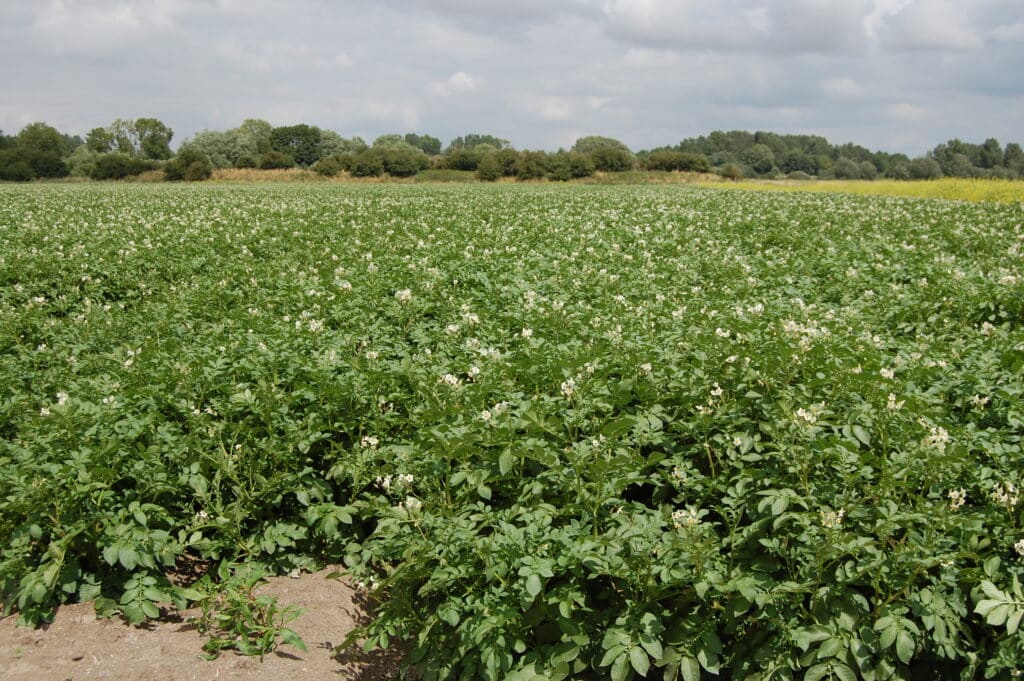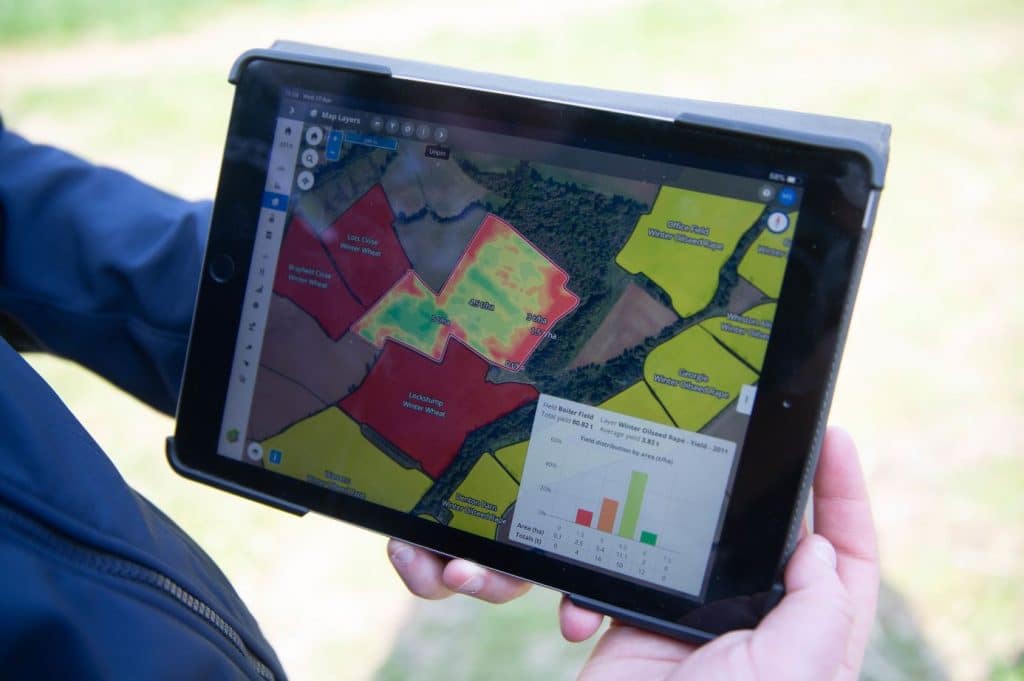In search of the sweet spot for store efficiency – British Potato Review
In this month’s season focus, Andrew Goodinson discusses how recent storage innovations can provide useful tools for growers, from the field to a QR code when the crop is marketed...
When it comes to storage, attention to detail is crucial to prevent unwanted crop deterioration and subsequent losses and flexibility of when to move the crop.
“Although most processors are good at moving potatoes if there is a storage problem, this a last resort and to be avoided if possible,” said Andrew.
“When you think about the amount of time and effort put into creating the best strategies for growing a crop, storage is often something of a poor relation, and many growers are still having to manage with old-fashioned stores.”
Whatever the storage regime, he says there are key issues to consider: Packing potatoes need to be stored below 4C to slow disease development and prolong dormancy, whereas processing potatoes need temperatures above 7C to prevent sugar levels developing.
However, this increases the need for sprout suppression. At more ambient temperatures, the tubers continue to respire and age more quickly, losing turgidity.
“Now is also a good time to check that the stores are in good order, and fans and ventilation systems are working properly,” said Andrew. “A good place to start is an audit to identify any air leakage resulting in temperature changes, uneven airflow and impact on the efficacy of sprout control. So it is always a good idea to have tests done on stores whilst they are empty and there is still time to make any necessary repairs before the crop is harvested.
“At the same time, it is a good idea to use sensors to check for any light ingress, too.”
He also reminds growers that stores should be cleaned, and fans and chiller units serviced and results recorded.
“Contaminated dust and debris is a major source of infection for many diseases, including black dot, dry rot, gangrene and silver scurf.
“Dust removal reduces the chances of crop infection, improves the working environment and demonstrates a holistic approach to store management. Vacuum, rather than sweep, to remove dirt and dust from all horizontal surfaces and follow this with a power hose.”
Boxes and equipment
If boxes are used for storing potatoes, he recommends using a power hose to remove residues and disease or otherwise leaving them exposed to outside (UV) light.
Harvesters and grading equipment should also be cleaned with a power hose and ideally treated with a disinfectant, particularly if infection was found last season.
He reminds growers that tubers are still respiring in the store, and respiration rates can increase when temperatures are warmer, resulting tubers losing weight. As a result, storage temperature, humidity and airflow need more carefully monitoring than grain or hay stores.
Inverters which adjust fans and ‘tune’ ventilation to the needs of the store at a particular time are crucial, he adds, noting that box stores are particularly challenging when it comes to ventilation.
“There is a need to ensure optimum airflow and access for crop inspection with the use of air passages between the boxes. Moreover, many stores are still fitted with passive rather than positive ventilation.”
Andrew recommends those considering vesting in new storage facilities to consult with industry experts, taking into account some of he newer technologies which have emerged.
“Technology is now available to monitor stores, and this can provide the information that we can act on.”
For example, carbon dioxide monitors can link to artificial intelligence programmes and connect to the fans, adjusting speed and direction where necessary. Other programmes use hybrid ventilators to assess air pressure throughout the store and create dynamic ventilation according to the need at the time.
“These technologies can really help with drying, curing and ensuring the stored crop remains at the best possible quality for the longest possible time. Subtle changes, thanks to technology, can have a big impact on the quality of the tubers over the storage period.
“Humidity needs to be between 92-97%, and if stores go below that, tubers can lose turgidity and therefore weight and quality. Moreover, if the store temperature is higher than the temperature of the structure, it can lead to condensation, and excess moisture resulting in crop breakdown.”
Rot progression
Rots are one of the biggest causes of crop loss from storage, he said, noting that the ease and speed of which they can move from one potato to another can make control quite challenging.
“Once disease such as soft rot has become established, it can progress very rapidly and, if uncontrolled, can cause significant loss of quality and subsequent rejection of loads.
Usually the first signs of rot are detected by the store manager’s nose, says Andrew, adding that a system, which is sufficiently sensitive to detect these odours well below the human level, may provide more opportunities for action to be taken sooner.
These instruments could be deployed anywhere in store to identify the location of the problem, allowing the store manager to alter ventilation, change the environment or even decide to move the crop.
Practical matters such as store size and design remain key too, he adds.
“We often find stores can be too big for today’s operations, so if, for example, you supply a number of different customers or markets, the option of having bays separated is very useful.
“Separate bays can also allow you to manage and vary airflow according to the needs of each bay at a particular time. Another potential benefit is that potatoes lifted in difficult conditions can be kept separate from those that may need different management.”
Air divider curtains can help improve temperature uniformity in overhead throw (OHT) stores, but these may need further fine-tuning to achieve uniformity under the particular conditions of individual stores.
“Plenum chambers are a realistic alternative to a curtain upgrade. These range from an open- fronted design with a ‘shelf’ to prevent short- circuits through to more sophisticated options with multiple fans and laser-cut plenum walls.
“Maximising the value of the potato crop through storage and preserving the key characteristics such as quality and dry matter is key for growers.”
As the sector is under pressure to reduce its carbon footprint, which for storage can be as high as 38% of the total footprint of the total, optimising store performance is key, Andrew stressed.
Using technology to refine systems and maximise returns
New digital farming systems now available to growers are capable of providing a picture of the life cycle of the potato from the field at planting all the way to market, Andrew has highlighted.
“With more consumers becoming interested in how their food is produced, and the need for ever more justification being demanded around the use of fertilisers and crop protection, these tools are a great help when it comes to complete traceability of all the stages of the crop,” he said.
Growers considering investing in new technology should think about the features they want and will use, plus the technology must be easy to use as well as linking in with existing farm equipment.
He explains that technology such as Hutchinsons’ Omnia use information from GPS, sensors, drones and Terramap, and photographs of drainage maps can be scanned and uploaded alongside data from many other external sources. Information is stored in one place and can be accessed from a smart phone.
Such technology allows fields to be divided into sub-levels with recordings assigned to each block according to user needs, Andrew said.
“This permits both the grower and agronomist to devise, review and track fertiliser plans, planting schedules, and spray programmes.
The system can also build yield maps, undertake cost analysis which helps refine operations and ultimately enhance the bottom line.”
“Growers can easily record sprays and pesticide applications by crop, field or variety, which is particularly important for potato growers as it helps them achieve the end-to-end traceability which is increasingly demanded by their customers. Moreover, the data can be interrogated for bespoke audit checks.”
In addition, the latest status of crop protection products can be obtained through such technology that is linked to a pesticide database, Andrew said, while satellite imagery provides accurate normalised difference vegetation index (NDVI) maps, which can be used to help optimise nitrogen uptake and efficiency.
“The system works in real time and once field operations have been completed, this information immediately becomes available to the grower, creating a diary and a history of the crop,” he said.
Those in the field can also upload photos, which is useful for visually assessing crop growth stage and the result of yield digs remotely, creating a pictorial history. This could be showing ladybirds eating aphids in the crop, or to help identify disease outbreaks, such as distinguishing between late blight and Alternaria, for example.
Many growers in the field can use such technology to record harvesting data and later assess operation costs and carbon footprint. For growers with more than one customer, they can send the data of the particular fields of interest, rather than having to share information about the whole-farm, he added.

